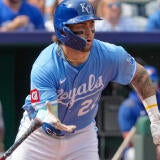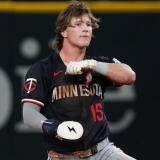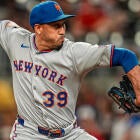Fantasy Baseball: Recapping Scott White's Tout Wars failure
He thought he had it this year, but it wasn't to be. Scott White explores what went wrong for his Tout Wars team, revisiting missteps such as investing too much in Blake Snell and passing up Ketel Marte late in the draft.
Well, that didn't go at all as planned.
My first two years in Tout Wars went smoothly enough. Playing in the "online draft" wing of the multi-format experts league, I finished second and third, which was better than I was expecting either time. The 15-team Rotisserie format isn't one I'm well-versed in, and I had been reading about this particular experts league since the days when I was more concerned with GPA than wOBA. So I'll admit in those first two years to being unsure of myself at every step along the way.
But this year was supposed to be different. This year, there was no second-guessing or overthinking. There was just process, my process. So when the draft came in early March, I did the only thing left to do: I crushed it.
Now, the uncertainty I felt in my first two Tout Wars seasons isn't the norm for me. I'm used to coming away from drafts feeling good about my team. I've been drafting more than a dozen every year for over a decade, and I like to think to have a good track record with it. So when I say I crushed it, I don't mean in the flippant sort of way I might describe any old draft where things more or less went according to plan. No, I mean I had my hands in something miraculous wherein things kept breaking so unbelievably in my favor that victory seemed like it was mine by right.
I basically wrote as much at the time, stating in no uncertain terms that I was the favorite and this was my year.
So what happened? I tied for sixth. After that draft. In that league. Sixth. And not even outright, but a tie. What follows, then, is what I should probably call my mea culpa. I don't want to, but it's true.
Things started out well enough. As late as mid-May, I was in second place, just behind archnemesis Rudy Gamble of Razzball, who had won the league each of my first two years in it. It was a familiar spot and one I was comfortable with, especially knowing that my first two picks, Jose Ramirez and Blake Snell, had delivered next to nothing so far. So far, I thought.
But it was just the beginning of my problems, it turns out. I suppose the best place to start is how my team looked in the beginning. The number in parentheses is the round in which I drafted each player (15 teams, remember).
Starting lineup (after the draft):
C - Wilson Ramos, NYM (11)
C - Austin Barnes, LAD (22)
1B - Anthony Rizzo, CHC (3)
2B - Scooter Gennett, CIN (7)
3B - Jose Ramirez, CLE (1)
SS - Andrelton Simmons, LAA (19)
CI - Max Muncy, LAD (9)
MI - Robinson Cano, SEA (8)
OF - George Springer, HOU (4)
OF - Jesse Winker, CIN (10)
OF - Billy Hamilton, KC (13)
OF - Kyle Tucker, HOU (21)
OF - Lewis Brinson, MIA (24)
U - Pete Alonso, NYM (15)
P - Blake Snell, TB (2)
P - Zack Greinke, AZ (5)
P - Craig Kimbrel, FA (6)
P - Jon Gray, COL (12)
P - Jordan Hicks, STL (14)
P - Matt Barnes, BOS (16)
P - Carlos Martinez, STL (17)
P - Tyler Skaggs, LAA (18)
P - Wade Miley, HOU (26)
Bench:
2B - Jeff McNeil, NYM (20)
SS - Didi Gregorius, NYY (23)
OF - Tyler O'Neill, STL (25)
OF - Clint Frazier, NYY (27)
2B - Brandon Lowe, TB (28)
P - Mike Soroka, ATL (29)
Clearly, there are some hits here. Pete Alonso and Jeff McNeil were both top priorities for me and both delivered big for where I drafted them. Max Muncy was quality pick. Anthony Rizzo and Wilson Ramos were fine. Even Ramirez, who had that miserable start and lost much of the second half to injury, made a reasonable enough contribution, especially given the scarcity of stolen bases. And then there's George Springer, who I thought was one of the more uninspired picks at the time but who ended up delivering second round-type numbers with a fourth-round pick. The problem was that none of the other outfielders panned out, not unless you count Brandon Lowe for the half a year he was healthy.
But you know, that particular problem wasn't even so bad when you consider where I ranked in the offensive categories at season's end. I was first in on-base percentage, second in both home runs and RBI and middle of the pack in runs scored. It would have helped if Billy Hamilton had bounced back as a prolific base-stealer, but of the 85 points my team scored, 54 were provided by my hitting. As was the story in every league where I wasn't especially competitive, it was the pitching that let me down.
It's a tough pill to swallow, too, because I feel like I was at the forefront of recognizing the importance of snagging high-end pitching early in a year when hitting turned out to be so prevalent that high-end pitching was the only real currency. But that approach of course exposed me to the inherent volatility of pitching — namely health. In the leagues where I got the right pitchers, it worked out swimmingly. In the leagues where I got Snell, not so much.
That volatility just reinforces the need for redundancies at the position, especially in an environment where hitting is so easy to backfill. In a worst case, those redundancies fill in the gaps created by injury and underachievement. In a best case, they become massive trade chips in an environment where, again, high-end pitching is the only real currency. You need to patch up a neglected lineup? An extra big arm can do it in one fell swoop.
You'll notice I completely whiffed on the hitters I selected in the seventh, eighth, 10th and 13th rounds, and yet my hitting still turned out strong because the waiver wire continually churned out usable hitters. But when I whiffed on a pitcher, there was little I could do other than patch the hole with a middle reliever.
You'll get a sense of how things played out when you compare the roster I drafted to the one I was using at seasons end. This time, the parenthetical info indicates how I acquired each player.
Starting lineup (at season's end):
C - Wilson Ramos, NYM (draft)
C - Carson Kelly, ARI (free agent)
1B - Anthony Rizzo, CHC (draft)
2B - Max Muncy, LAD (draft)
3B - Jose Ramirez, CLE (draft)
SS - Bo Bichette, TOR (free agent)
CI - Pete Alonso, NYM (draft)
MI - Gavin Lux, LAD (free agent)
OF - George Springer, HOU (draft)
OF - Jeff McNeil, NYM (draft)
OF - Giancarlo Stanton, NYY (free agent)
OF - Jason Heyward, CHC (free agent)
OF - Kyle Tucker, HOU (draft)
U - Brandon Lowe, TB (draft)
P - Blake Snell, TB (draft)
P - Zack Greinke, AZ (draft)
P - Yu Darvish, CHC (trade)
P - Caleb Smith, MIA (free agent)
P - Ken Giles, TOR (free agent)
P - Craig Kimbrel, CHC (draft)
P - Ian Kennedy, KC (free agent)
P - Giovanny Gallegos, STL (free agent)
P - Andres Munoz, SD (free agent)
Bench:
SS - Didi Gregorius, NYY (draft)
1B - Edwin Encarnacion, NYY (free agent)
1B - Daniel Vogelbach, SEA (free agent)
2B - Mauricio Dubon, SF (free agent)
P - Wade Miley, HOU (draft)
P - Tommy Kahnle, NYY (free agent)
One abnormal rule in this league is that you can drop a player who suffers a long-term injury and get some FAAB dollars back for him, which is how Giancarlo Stanton, Ken Giles and Edwin Encarnacion were available to me in free agency. I just kept scooping up those guys and stashing them in IL spots until I could use them. It was a low-risk, high-reward maneuver that didn't really pan out in the long run.
But back to the pitching issue ... it's not like I didn't have an ace. Zack Greinke did exactly what he was supposed to do, and because I acquired Yu Darvish early enough to get the full benefit of his turnaround, I still ended up with two even with the near-lost season for Snell. And it still wasn't enough. I just didn't have a high enough volume of quality innings to fill in the gaps as they appeared, not wanting to wreck my ERA and WHIP with some scrub off the waiver wire. So fittingly, my two worst categories were the two most influenced by starting pitching, wins and strikeouts, between which I scored a combined seven points.
What's funny is that none of the three closers I drafted — Craig Kimbrel, Jordan Hicks and Matt Barnes, who together I thought would give me a leg up in the category — really amounted to anything, and yet I still finished in the middle of the pack in saves. Even in a league as deep as 15 teams, it's not a category you should have to pay for.
Notice I didn't mention Carlos Martinez as one of my sources for saves. You may remember he initially returned as a middle reliever. Ain't no one got the roster space for that.
So anyway, the bottom line is that while starting pitching isn't everything, it's pretty close. And particularly for that part of the draft when the high-end types are still available, you may want to go even heavier after them it in anticipation of something going wrong, trusting yourself to piece together a competitive lineup in the late rounds or off the waiver wire. In this homer-happy environment, it's more plausible than attempting to build a team the other way around.
A few superlatives before I put a bow on this embarrassment:
Best draft decision: Taking Pete Alonso in Round 15. No dur.
Worst draft decision: Passing up Ketel Marte as my starting shortstop for Andrelton Simmons in Round 19. I knew Marte had more upside, and my approach in this league has always been to forgo the boring in the late rounds. But I didn't think he had as much upside as Didi Gregorius, who I fully expected to get a few rounds later, and I for some reason was worried about Marte's playing time because of Wilmer Flores. Whatever, it was dumb ... probably the worst decision I made in any league all year.
Bad draft decision that actually wasn't so bad: I was roundly criticized for passing up Francisco Lindor for Snell late in Round 2. At the time, Lindor was contending with a nasty calf injury and an uncertain timetable, and I knew I wouldn't have a shot at another ace if I didn't take one at the 2-3 turn. Obviously, my team would have been better with Lindor than Snell, but since I wasn't hurting for hitting, it wouldn't have made a huge difference. I maintain I made the right decision going after the pitcher. I just got the wrong pitcher.
Best free-agent pickup: It has to be Bo Bichette, right? He finally resolved the shortstop issue that I could have prevented with either Lindor or Marte. I picked him up on July 1, about a month before he got the call, and I have a history of doing that with high-end prospects in this league (see Juan Soto last year and Rhys Hoskins in 2017). As deep as it is and as plentiful as roster space is with the infinite IL spots, I don't know why more of my competitors don't take this approach. Maybe I shouldn't speak too loudly.
Worst free agent pickup: I blew 167 (or 16.7 percent) of my FAAB dollars on Zach Eflin in mid-June, which was about the time he predictably blew up. So I made a big investment in making a bad situation worse. That's why you really don't want to have to trust in those scrubby types, even when they're going well.
Worst drop: You may have noticed I drafted Mike Soroka in the last round and yet never made mention of him when discussing my starting pitching. Yeah ... I dropped him for Caleb Smith before the season even started. It seemed brilliant at first!
Best trade: Well, I made only two, and one was a minor deal to give me a few extra FAAB dollars at the end of the year. The other saw me deal Clint Frazier and 156 FAAB dollars for Yu Darvish in late April, which made me super nervous since Darvish was a mess at the time and Frazier was looking like he was on the verge of a breakthrough at a position of real need for me. But I knew I'd normally have to pay a fortune for a high-end pitcher and thought Darvish still had that kind of potential. Buying low seemed like the only realistic way of improving my pitching through trade, and it worked out in this case. Maybe I should have tried doing it a couple more times.
I'd be remiss not to point out that while I finished sixth, the winner was Ray Murphy of Baseball HQ, so congratulations to him. And no congratulations this year for Rudy Gamble, who finished (ha-ha!) fourth.
Like I have a right to laugh.























